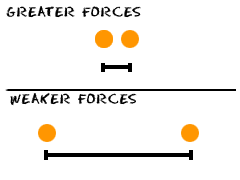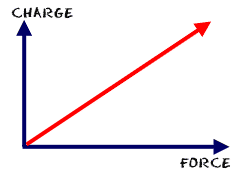Coulomb Basics
Coulomb's Law is one of the basic ideas of electricity in physics. The law looks at the forces created between two charged objects. As distance increases, the forces and electric fields decrease. This simple idea was converted into a relatively simple formula. The force between the objects can be positive or negative depending on whether the objects are attracted to each other or repelled. Think about a few concepts before you continue reading. Some charges are attracted to each other. Positive and negative charges like to move towards each other. Similar charges such as two positive or two negative push away from each other. You also need to understand that forces between objects become stronger as they move together and weaker as they move apart. You could yell at someone from far away, and they would barely hear you. If you yelled the same amount when you were together, it would be more powerful and loud.
Think about a few concepts before you continue reading. Some charges are attracted to each other. Positive and negative charges like to move towards each other. Similar charges such as two positive or two negative push away from each other. You also need to understand that forces between objects become stronger as they move together and weaker as they move apart. You could yell at someone from far away, and they would barely hear you. If you yelled the same amount when you were together, it would be more powerful and loud.Coulomb's Work
Charles Augustin de Coulomb was a French scientist working in the late 1700's. A little earlier, a British scientist named Henry Cavendish came up with similar ideas. Coulomb received most of the credit for the work on electric forces because Cavendish did not publish all of his work. The world never knew about Cavendish's work until decades after he died.Coulomb's Law
 But you're here to learn about the law. When you have two charged particles, an electric force is created. If you have larger charges, the forces will be larger. If you use those two ideas, and add the fact that charges can attract and repel each other you will understand Coulomb's Law. It's a formula that measures the electrical forces between two objects.
But you're here to learn about the law. When you have two charged particles, an electric force is created. If you have larger charges, the forces will be larger. If you use those two ideas, and add the fact that charges can attract and repel each other you will understand Coulomb's Law. It's a formula that measures the electrical forces between two objects.
F=kq1q2/r2
"F" is the resulting force between the two charges. The distance between the two charges is "r." The "r" actually stands for "radius of separation" but you just need to know it is a distance. The "q1" and "q2" are values for the amount of charge in each of the particles. Scientists use Coulombs as units to measure charge. The constant of the equation is "k." As you learn more physics, you will see that this formula is very similar to a formula from Newton's work with gravity.
REVIEW:
Coulomb's Law
- The interaction between charged objects is a non-contact force that acts over some distance of separation. Charge, charge and distance.
- Every electrical interaction involves a force that highlights the importance of these three variables.
- Whether it is a plastic golf tube attracting paper bits, two like-charged balloons repelling or a charged Styrofoam plate interacting with electrons in a piece of aluminum,
- there is always two charges and a distance between them as the three critical variables that influence the strength of the interaction.